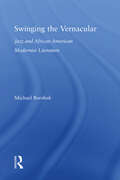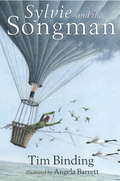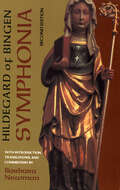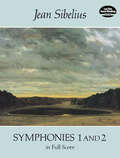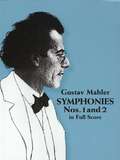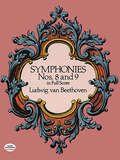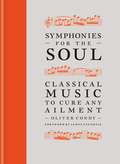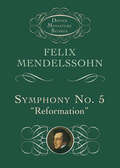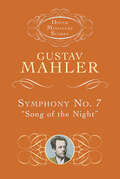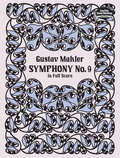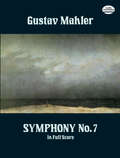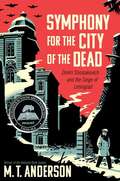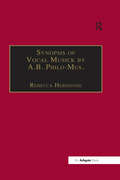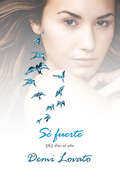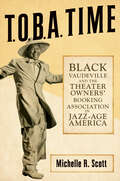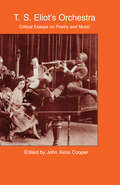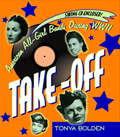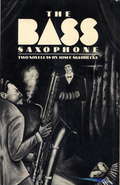- Table View
- List View
Swinging the Vernacular: Jazz and African American Modernist Literature
by Michael BorshukThis book looks at the influence of jazz on the development of African American modernist literature over the 20th century, with a particular attention to the social and aesthetic significance of stylistic changes in the music.
Swissted: Vintage Rock Posters Remixed and Reimagined
by Mike Joyce&“Fine art for font nerds.&”—New York Magazine &“One of the most engaging homages I have ever seen.&”—Steven HellerSwissted takes rock concert posters of the &’70s, &’80s, and &’90s and remixes and reimagines them through a Swiss modernist lens. The result is some of the coolest images you&’ve ever seen! The book features 200 posters, all microperforated and ready to frame. Or keep them bound in one collection as an art book. The foreword is written by legendary designer Steven Heller. Posters are from legendary indie, alternative, and punk bands such as Jane&’s Addiction, Blondie, the Beastie Boys, the Clash, the Pixies, Green Day, the Ramones, Devo, the Sex Pistols, Dead Kennedys, Public Image Ltd., Sonic Youth, the Cure, Red Hot Chili Peppers, Hüsker Dü, Danzig, the Replacements, Fugazi, the Lemonheads, Pearl Jam, Pavement, Superchunk, They Might Be Giants, Guided by Voices, Sugar, Sleater Kinney, Violent Femmes, Iggy Pop, Fishbone, Nirvana, and many, many more!
Sylvie and the Songman
by Tim BindingA compelling story full of magic and music. Sylvie Bartram lives alone with Mr. Jackson the dog and her eccentric composer father, who invents strange and wonderful musical instruments. One day she returns from school to find a message left in toothpaste on the bathroom mirror: her father has been kidnapped. Later that night, the house is visited by a terrifying apparition—a half-man, half-creature who is searching for something and will not rest until he has found it. . . . Sylvie uncovers an underground world of magic and evil, and with help from her friends, she must hold off a power that threatens the lives of all beings in the world. The Songman is at large, and is determined to steal music and use it for his own evil ends. . . . From the Hardcover edition.
Symphonia: A Critical Edition of the "Symphonia Armonie Celestium Revelationum" (Symphony of the Harmony of Celestial Revelations)
by Hildegard of BingenFor this revised edition of Hildegard's liturgical song cycle, Barbara Newman has redone her prose translations of the songs, updated the bibliography and discography, and made other minor changes. Also included is an essay by Marianne Richert Pfau which delineates the connection between music and text in the Symphonia.Famous throughout Europe during her lifetime, Hildegard of Bingen (1098-1179) was a composer and a poet, a writer on theological, scientific, and medical subjects, an abbess, and a visionary prophet. One of the very few female composers of the Middle Ages whose work has survived, Hildegard was neglected for centuries until her liturgical song cycle was rediscovered. Songs from it are now being performed regularly by early music groups, and more than twenty compact discs have been recorded.
Symphonies 1 and 2: In Full Score
by Jean SibeliusFinland's greatest composer and a major figure in the development of Scandinavian music, Jean Sibelius (1865-1957) is admired for his complete mastery of symphonic form. Of the seven symphonies he composed, each differs greatly from the others, for Sibelius rarely approached the symphonic "problem" the same way. Each work seems committed to the thoughts, feelings, and logic of the movement.Sibelius's first two symphonies remain among his most accessible and popular. Of all his symphonic works, perhaps the First Symphony, composed in 1898-99, adheres most to classical form yet reflects the spirit of Nordic nationalism that came to be associated with the composer's music.The Second Symphony, perhaps his most expansive and melodious work in symphonic form, demonstrates Sibelius's increasing command of orchestral form and scoring. These two major works are reprinted here from the definitive full-score editions published by Breitkopf & Härtel, Leipzig.
Symphonies Nos. 1 and 2 in Full Score
by Gustav MahlerOften regarded as the last great composer in the Austro-Germanic tradition, Gustave Mahler (1860-1911) exerted a major influence on 20th-century music; his later work in particular affected the musical ideas of such composers as Arnold Schoenberg, Dimitri Shostakovich, Alban Berg, and Benjamin Britten.While his mature work foreshadowed radical elements of modern music -- particularly the dissolution of tonality -- Mahler's first symphonies were written in a relatively traditional programmatic style with a strong spiritual element. These early works are seen by some critics as attempting to "establish some ultimate ground for existence in the face of pain, death, doubt, and despair." The composer's spiritual quest, as well as the vivid orchestration, innovative symphonic structure, and rich emotional expression that characterized his music can be clearly studied and appreciated in this volume, which contains complete scores of Mahler's first two symphonies.Of the Symphony No. 1 in D Major ("Titan"), the Encyclopaedia Britannica notes, "The program of the purely orchestral Symphony No. 1 in D Major ... is autobiographical of his youth; the joy of life becomes clouded over by an obsession with death in the macabre "Funeral March in the Manner of Callot (basically a parody of popular music), which is eventually routed in the arduous and brilliant finale."Of Symphony No. 1 in C Minor, ("Resurrection"), Grove's Dictionary of Music and Musicians states: "Symphony II is a good example of all Mahler's works ... scored nearly always heavily for a large orchestra, restless and stormy in places, monumentally exalted in others."Now both works are available in this handsome, inexpensive edition, reproduced directly from the original editions published by Josef Weinberger in Vienna in 1897 and 1899. Beautifully printed with wide margins and clear noteheads, this edition of the symphonies offers an unparalleled resource for studying and enjoying the seminal works of a modern master.
Symphonies Nos. 6 and 7 in Full Score (Dover Orchestral Music Scores)
by Antonín DvorákWhile the immense popularity of Dvořák's Symphony No. 9, "From the New World," has somewhat overshadowed his other symphonic works, the two symphonies reprinted here are superb compositions in their own right. Indeed, the Symphony No. 7 in D Major is considered by many music authorities to be Dvořák's finest achievement in the symphonic form. Its strong, concise development, great emotional depths, and heroic spirit have won the work many admirers among critics and public alike.Regarding the Symphony No. 6, Grove's Dictionary has this to say: "The joyous Symphony in D Major, Op. 60, full of the fragrance and melody of the Czech fields and forests, full of light and cheerful courage, with the furiant in the scherzo, is a work of striking originality."This handsome, durable volume affords music lovers the opportunity to study these great scores, carefully and accurately reproduced from an authoritative German edition.
Symphonies Nos. 8 and 9: In Full Score
by Ludwig Van BeethovenBeethoven's symphonies are among his greatest works -- in the opinion of many, the greatest orchestral compositions in the history of music. Perfect in their fusion of emotion and form, filled with drama and great beauty, they are among the best-known and best-loved works in all classical music. This volume contains complete scores for Symphony No. 8 in F Major, Op. 93, and Symphony No. 9 in D Minor, Op. 125.The eighth is full of beauty and innocent merriment, while the ninth is Beethoven's best and greatest symphony, a dazzling end to his symphonic works. Also included here is a translation of the passage from Schiller's ode "To Joy," featured in the last movement. Meticulously reproduced from the authoritative Litolff edition, each score features large, clear noteheads and wide margins for ease of use in studying and following the music. Far less expensive than comparable full-score editions, this volume belongs in the library of any music lover who wishes to study the masterly innovation and creativity Beethoven brought to the symphonic form.
Symphonies and Other Orchestral Works
by Donald Francis ToveyOver 100 critical essays about symphonies and other orchestral works from the author.
Symphonies and Other Orchestral Works: Selections from Essays in Musical Analysis
by Donald Francis ToveyMore than 100 selections from the noted musicologist's Essays in Musical Analysis cover most of the standard works in the symphonic repertory. Subjects include Beethoven's overtures and symphonies, including the author's famous study of the Ninth Symphony; all Brahms's overtures and symphonies; 11 symphonies by Haydn; six by Mozart; three symphonies each by Schubert, Schumann, and Sibelius; four symphonies by Dvoràk; and many other works by composers from Bach to Vaughan Williams.Donald Francis Tovey's Essays in Musical Analysis ranks among the English language's most acclaimed works of musical criticism. Praised for their acuteness, common sense, clarity, and wit, they offer entertaining and instructive reading for anyone interested in the classical music repertoire.
Symphonies for the Soul: Classical music to cure any ailment
by Oliver Condy***With a foreword by James NaughtieWithin the pages of this book lie musical prescriptions that offercomfort, solace and strength in the face of dark times.Whether you suffer from loneliness or laziness, from bereavement or betrayal, a heartbreak or a mere hangover, here you'll find the perfect piece of classical music to heal the heart, soothe the soul and cure the maladies of the modern world.Musician and writer Oliver Condy takes the role of musical physician, using his years of experience to prescribe remedies for all manner of ailments in the form of classical music.A beautifully-packaged gift book with more than 100 recommendations, Symphonies for the Soul is filled with fascinating stories behind the pieces and composers selected, and how in their own unique ways they can nourish the spirit in times of need.
Symphonies for the Soul: Classical music to cure any ailment
by Oliver Condy***With a foreword by James NaughtieWithin the pages of this book lie musical prescriptions that offer comfort, solace and strength in the face of dark times.Whether you suffer from loneliness or laziness, from bereavement or betrayal, a heartbreak or a mere hangover, here you'll find the perfect piece of classical music to heal the heart, soothe the soul and cure the maladies of the modern world.Musician and writer Oliver Condy takes the role of musical physician, using his years of experience to prescribe remedies for all manner of ailments in the form of classical music.A beautifully-packaged gift book with more than 100 recommendations, Symphonies for the Soul is filled with fascinating stories behind the pieces and composers selected, and how in their own unique ways they can nourish the spirit in times of need.
Symphony No. 5: "Reformation"
by Felix MendelssohnIn this staple of the orchestral repertoire, Mendelssohn interprets the Reformation in symphonic terms, building to a powerful series of variations on Martin Luther's confessional chorale, Ein feste Burg ist unser Gott (A Mighty Fortress Is Our God). This miniature score is reproduced from an authoritative edition, complete with numbered movements for easy reference. Affordable and compact, it is ideal for use in the classroom, at home, or in the concert hall.
Symphony No. 7: "Song of the Night"
by Gustav MahlerMahler's seventh symphony ranks among the composer's most popular and accessible works. Possessing neither a "program" nor a folk-song theme, it is a purely instrumental composition, both hopeful and romantic in mood, with a harmonic and stylistic structure that evokes the daily journey from dusk till dawn. This miniature score is reproduced from an authoritative edition, complete with numbered movements for easy reference. Affordable and compact, it is ideal for use in the classroom, at home, or in the concert hall.
Symphony No. 9 In Full Score (Dover Orchestral Music Scores)
by Gustav Mahler"Mahler inherited the romantic conception of music as an expression of a quest for spiritual reality … he expressed a four-sided conflict between a devouring love of life, a spiritual need, a skeptical intellect, and an existential dread of ultimate meaninglessness." — Encyclopaedia Britannica.In this great work, Mahler experimented with the four-movement symphonic form, producing a masterpiece of musical innovation, satiric writing, and poetic drama expressed in purely instrumental terms. Alban Berg referred to the first movement of the Ninth Symphony as "the most glorious [Mahler] ever wrote," and further observed, "the whole movement is based on a premonition of death which constantly recurs … that is why the tenderest passages are followed by tremendous climaxes like new eruptions of a volcano."Now the full orchestral score of the Ninth Symphony is available in the inexpensive, high-quality edition, reprinted from an authoritative Viennese score. Music lovers and admirers of Mahler's work will find in these pages abundant evidence of the fresh and formidable thinking the composer brought to this monumental composition.
Symphony No. 9 In Full Score (Dover Orchestral Music Scores)
by Gustav Mahler"Mahler inherited the romantic conception of music as an expression of a quest for spiritual reality ... he expressed a four-sided conflict between a devouring love of life, a spiritual need, a skeptical intellect, and an existential dread of ultimate meaninglessness." -- Encyclopaedia Britannica.In this great work, Mahler experimented with the four-movement symphonic form, producing a masterpiece of musical innovation, satiric writing, and poetic drama expressed in purely instrumental terms. Alban Berg referred to the first movement of the Ninth Symphony as "the most glorious [Mahler] ever wrote," and further observed, "the whole movement is based on a premonition of death which constantly recurs ... that is why the tenderest passages are followed by tremendous climaxes like new eruptions of a volcano."Now the full orchestral score of the Ninth Symphony is available in the inexpensive, high-quality edition, reprinted from an authoritative Viennese score. Music lovers and admirers of Mahler's work will find in these pages abundant evidence of the fresh and formidable thinking the composer brought to this monumental composition.
Symphony for the City of the Dead: Dmitri Shostakovich and the Siege of Leningrad
by M. T. AndersonNational Book Award winner M. T. Anderson delivers a brilliant and riveting account of the Siege of Leningrad and the role played by Russian composer Shostakovich and his Leningrad Symphony. In September 1941, Adolf Hitler's Wehrmacht surrounded Leningrad in what was to become one of the longest and most destructive sieges in Western history--almost three years of bombardment and starvation that culminated in the harsh winter of 1943-1944. More than a million citizens perished. Survivors recall corpses littering the frozen streets, their relatives having neither the means nor the strength to bury them. Residents burned books, furniture, and floorboards to keep warm; they ate family pets and--eventually--one another to stay alive. Trapped between the Nazi invading force and the Soviet government itself was composer Dmitri Shostakovich, who would write a symphony that roused, rallied, eulogized, and commemorated his fellow citizens--the Leningrad Symphony, which came to occupy a surprising place of prominence in the eventual Allied victory. This is the true story of a city under siege: the triumph of bravery and defiance in the face of terrifying odds. It is also a look at the power--and layered meaning--of music in beleaguered lives. Symphony for the City of the Dead is a masterwork thrillingly told and impeccably researched by National Book Award-winning author M. T. Anderson.
Synopsis of Vocal Musick by A.B. Philo-Mus.
by A. B. Philo-mus.Synopsis of Vocal Musick, by the unidentified A.B., was published in London in 1680 and appears to have only ever had one edition. Its relatively short shelf-life belies its importance to the history of early British music theory. Unlike other English theoretical writings of the period, the Synopsis derives many of its aspects from the continental theoretical tradition, including the first references in English theory to the modern fractional time signatures that had been invented in Italy in the mid-seventeenth century, the first references in English to compound time and the first explanations of tempo terms such as Adagio and Presto. In these respects the treatise forms an important link between English and continental theoretical traditions and may have encouraged the adoption of Italian principles which became a common feature of English writings by the early eighteenth century. The treatise is essentially in two parts. The first section of the book comprises rudimentary instruction on understanding notation and intervals, descriptions of common vocal ornaments and instruction in the process of learning to sing. The second part consists of a selection of psalms, songs and catches which are provided as exercises for the singer, though several of them require a reasonably advanced degree of skill. These pieces provide valuable insight into the way both sacred and secular music might have been performed by amateur musicians in the Restoration period. They include 14 rare English madrigal settings by the Italian composer Gastoldi - further evidence of the Italian influence which pervades the text. This is the first modern edition of the Synopsis, and indeed the first edition to appear since its original publication.
Szymanowski, Eroticism and the Voices of Mythology
by Stephen DownesThe desire to voice the artistic revelation of the truth of a precarious, multi-faceted, yet integrated self lies behind much of Szymanowski's work. This self is projected through the voices of deities who speak languages of love. The unifying figure is Eros, who may be embodied as Dionysus, Christ, Narcissus or Orpheus, and the gospel he proclaims tells of the resurrection and freedom of the desiring subject. This book examines Szymanowski's exploration of the relationship between the authorial voice, mythology and eroticism within the context of the crisis of the modern subject in Western culture. Stephen Downes analyses mythological and erotic aspects of selected songs from the composer's early career, moving to an interpretation of the voice of the homoerotic lover, embodied as a mad muezzin, in terms of heroic notions of Orphic elegy. Discussing the encounters of King Roger with the voices of Narcissus, the Siren and Dionysus, Downes shows how the composer uses the unifying Christ/Eros figure as a means of indicating that the King might be transformed from anguished despot to loving expressive subject. The book ends with an examination of Szymanowski's desire to fuse Slavonic and Middle-Eastern mythological inspirations in an attempt to fulfil a utopian vision of a pan-European culture bound together by the spirit of Eros.
Sé fuerte. 365 días del año
by Demi LovatoEste es un libro para todas las personas, de todas partes, que están en un viaje personal y que necesitan consuelo, inspiración y una razón cada día para ser fuertes. «Da las gracias por tu viaje, porque solo es tuyo».Para la superestrella Demi Lovato la vida ha sido un viaje, una etapa en donde ha alcanzado logros deslumbrantes y ha sufrido pérdidas desgarradoras. Demi es una artista premiada con numerosos discos de platino, estrella de televisión y actriz. Se ha enfrentado con problemas que abarcan desde la adicción a la depresión. Todo mientras atravesaba por una fase de autodescubrimiento búsqueda de la felicidad. Demi ha relatado la crónica de su viaje en los medios de comunicación, en las letras de sus canciones y en twitter, con millones de seguidores.Sus tweets han evolucionado hasta convertirse en Sé fuerte, una poderosa colección de 365 días donde se recogen los puntos de vista más sinceros, valientes y esperanzados de Demi. Cada día a lo largo de este año de reflexión, se alimenta con una frase significativa para la autora y una meta a lograr por el lector en los momentos difíciles.Aquí están sus palabras, las citas que la inspiran, sus reflexiones y metas personales. Un libro para disfrutar cualquier año, en cualquier momento de la vida para sentirse fuerte.
Sé fuerte: 365 días del año
by Demi LovatoLa popular actriz y cantante, Demi Lovato, comparte con sus lectores sus reflexiones, opiniones y puntos de vista sobre diferentes aspectos de la vida. Para la superestrella Demi Lovato la vida ha sido un viaje, una etapa en donde ha alcanzado logros deslumbrantes y ha sufrido pérdidas desgarradoras. Este es un libro para todas las personas, de todas partes, que están en un viaje personal y que necesitan consuelo, inspiración y una razón cada día para ser fuertes. Demi Lovato es una artista premiada con numerosos discos de platino, estrella de televisión y actriz. Se ha enfrentado con problemas que abarcan desde la adicción a la depresión. Todo mientras atravesaba por una fase de autodescubrimiento y búsqueda de la felicidad. Demi ha relatado la crónica de su viaje en los medios de comunicación, en las letras de sus canciones y en twitter, con millones de seguidores. Sus tweets han evolucionado hasta convertirse en Sé fuerte, una poderosa colección de 365 días donde se recogen los puntos de vista más sinceros, valientes y esperanzados de Demi. Cada día a lo largo de este año de reflexión, se alimenta con una frase significativa para la autora y una meta a lograr por el lector en los momentos difíciles. Aquí están sus palabras, las citas que la inspiran, sus reflexiones y metas personales. Un libro para disfrutar cualquier año, en cualquier momento de la vida para sentirse fuerte.
T.O.B.A. Time: Black Vaudeville and the Theater Owners’ Booking Association in Jazz-Age America
by Michelle R. ScottBlack vaudevillians and entertainers joked that T.O.B.A. stood for “tough on black artists.” But the Theater Owner’s Booking Association (T.O.B.A.) played a foundational role in the African American entertainment industry and provided a training ground for icons like Cab Calloway, Bessie Smith, Ethel Waters, Sammy Davis Jr., the Nicholas Brothers, Count Basie, and Butterbeans and Susie. Michelle R. Scott’s institutional history details T.O.B.A.’s origins and practices while telling the little-known stories of the managers, producers, performers, and audience members involved in the circuit. Looking at the organization over its eleven-year existence (1920–1931), Scott places T.O.B.A. against the backdrop of what entrepreneurship and business development meant in black America at the time. Scott also highlights how intellectuals debated the social, economic, and political significance of black entertainment from the early 1900s through T.O.B.A.’s decline during the Great Depression. Clear-eyed and comprehensive, T.O.B.A. Time is a fascinating account of black entertainment and black business during a formative era.
T.S. Eliot's Orchestra: Critical Essays on Poetry and Music (Border Crossings #7)
by John Xiros CooperFirst Published in 2000. Nearly everyone who addresses T. S. Eliot's imaginative and critical work must acknowledge the importance of music in thematic and formal terms. This collection of original essays thoroughly explores this aspect of his work from a number of perspectives.
TAKE-OFF: American All-girl Bands During WWII
by Tonya BoldenThe 1940's was a time when society thought it improper for women to make a sax wail or let loose hot licks on skins, but with the advent of World War II and many men away fighting the war, women finally got their chance to strut their stuff on the bandstand. These all-girl bands kept morale high on the homefront and on USO tours of miltary bases across the globe while also helping to establish America's legacy in jazz music. "Take-off?" Oh, yeah. Several all-girl bands did. This book includes a hip swing CD.
THE BASS SAXOPHONE
by Josef SkvoreckyFirst published in 1980, The Bass Saxophone was chosen as Book of the Year by The Guardian. This internationally acclaimed classic of jazz literature is now available in a handsome new edition with a new contribution by the author. As an introduction to these two novellas, Skvorecky writes a remarkable personal memoir of his jazz-obsessed youth under two dictatorships. (2001)
